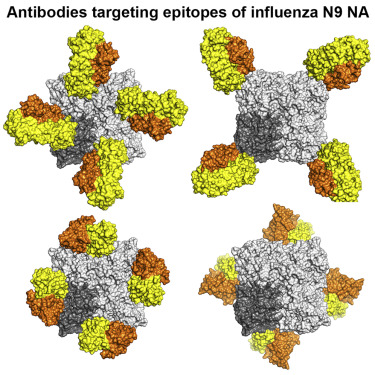当前位置:
X-MOL 学术
›
Cell Host Microbe
›
论文详情
Our official English website, www.x-mol.net, welcomes your feedback! (Note: you will need to create a separate account there.)
Structural Basis of Protection against H7N9 Influenza Virus by Human Anti-N9 Neuraminidase Antibodies.
Cell Host & Microbe ( IF 30.3 ) Pub Date : 2019-11-19 , DOI: 10.1016/j.chom.2019.10.002 Xueyong Zhu 1 , Hannah L Turner 1 , Shanshan Lang 1 , Ryan McBride 2 , Sandhya Bangaru 3 , Iuliia M Gilchuk 3 , Wenli Yu 1 , James C Paulson 2 , James E Crowe 4 , Andrew B Ward 1 , Ian A Wilson 5
Cell Host & Microbe ( IF 30.3 ) Pub Date : 2019-11-19 , DOI: 10.1016/j.chom.2019.10.002 Xueyong Zhu 1 , Hannah L Turner 1 , Shanshan Lang 1 , Ryan McBride 2 , Sandhya Bangaru 3 , Iuliia M Gilchuk 3 , Wenli Yu 1 , James C Paulson 2 , James E Crowe 4 , Andrew B Ward 1 , Ian A Wilson 5
Affiliation

|
Influenza virus neuraminidase (NA) is a major target for small-molecule antiviral drugs. Antibodies targeting the NA surface antigen could also inhibit virus entry and egress to provide host protection. However, our understanding of the nature and range of target epitopes is limited because of a lack of human antibody structures with influenza neuraminidase. Here, we describe crystal and cryogenic electron microscopy (cryo-EM) structures of NAs from human-infecting avian H7N9 viruses in complex with five human anti-N9 antibodies, systematically defining several antigenic sites and antibody epitope footprints. These antibodies either fully or partially block the NA active site or bind to epitopes distant from the active site while still showing neuraminidase inhibition. The inhibition of antibodies to NAs was further analyzed by glycan array and solution-based NA activity assays. Together, these structural studies provide insights into protection by anti-NA antibodies and templates for the development of NA-based influenza virus vaccines and therapeutics.
中文翻译:

人类抗N9神经氨酸酶抗体对H7N9流感病毒的保护作用的结构基础。
流感病毒神经氨酸酶(NA)是小分子抗病毒药物的主要靶标。靶向NA表面抗原的抗体也可以抑制病毒的进入和流出,以提供宿主保护。然而,由于缺乏具有流感神经氨酸酶的人抗体结构,我们对靶标表位的性质和范围的理解受到限制。在这里,我们描述了人类感染禽H7N9病毒与五种人类抗N9抗体的复合物中NA的晶体结构和低温电子显微镜(cryo-EM)结构,系统地定义了几个抗原性位点和抗体表位印迹。这些抗体完全或部分阻断NA活性位点或结合远离活性位点的表位,同时仍显示神经氨酸酶抑制作用。通过聚糖阵列和基于溶液的NA活性测定进一步分析了对NAs的抗体抑制。总之,这些结构研究为开发基于NA的流感病毒疫苗和治疗剂提供了抗NA抗体和模板保护的见解。
更新日期:2019-11-20
中文翻译:

人类抗N9神经氨酸酶抗体对H7N9流感病毒的保护作用的结构基础。
流感病毒神经氨酸酶(NA)是小分子抗病毒药物的主要靶标。靶向NA表面抗原的抗体也可以抑制病毒的进入和流出,以提供宿主保护。然而,由于缺乏具有流感神经氨酸酶的人抗体结构,我们对靶标表位的性质和范围的理解受到限制。在这里,我们描述了人类感染禽H7N9病毒与五种人类抗N9抗体的复合物中NA的晶体结构和低温电子显微镜(cryo-EM)结构,系统地定义了几个抗原性位点和抗体表位印迹。这些抗体完全或部分阻断NA活性位点或结合远离活性位点的表位,同时仍显示神经氨酸酶抑制作用。通过聚糖阵列和基于溶液的NA活性测定进一步分析了对NAs的抗体抑制。总之,这些结构研究为开发基于NA的流感病毒疫苗和治疗剂提供了抗NA抗体和模板保护的见解。



























 京公网安备 11010802027423号
京公网安备 11010802027423号